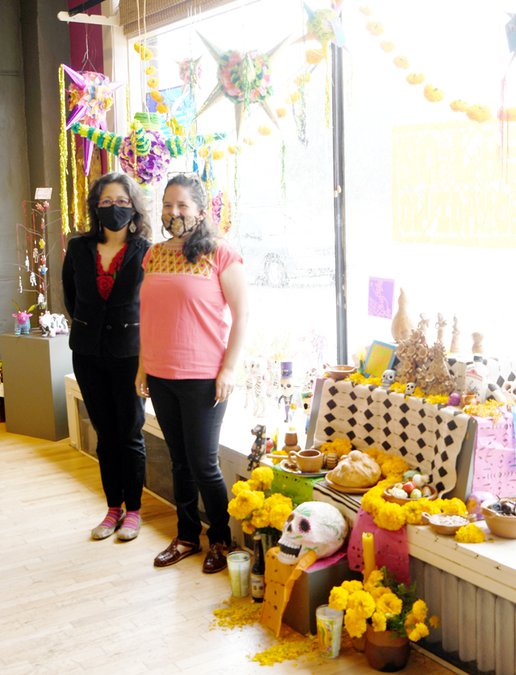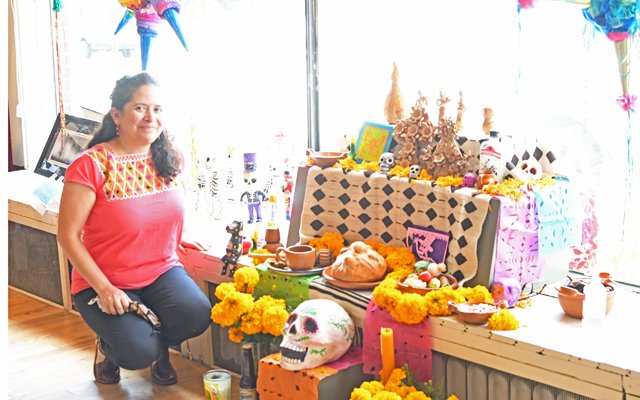VIROQUA - Artist Gabriela Marvan’s ‘Dia de los Muertos’ (Day of the Dead) exhibit at VIVA Gallery in October is dedicated to the “souls of the 10 women who are killed or disappear each day in Mexico.”
Gabriela Marvan is part of a collective of Mexican artists, which formed in the midst of the COVID-19 pandemic to face their struggles together.
“The origin of this idea began when I realized that my artist friends in Mexico were struggling with the pandemic situation. I know how talented they are, and I know that the world would be interested in knowing more about their art. Our goal with this collective is to develop a connection between the Mexican folk artists living in Mexico and the Mexican folk artists living in USA, empowering our art through sharing our process, our towns, our inspiration.”

The grand opening of Marvan’s exhibit in Viroqua on Thursday, Oct. 1, drew Mexico’s representative at the Consulate in Milwaukee, Norma Sanchez Arellanes, to attend the event. Though it was a cold, pouring rain outside, Arellanes was greeted with bright splashes of color inside the gallery. There were piñatas hanging in the window, and examples of Marvan’s art form, ‘cartoneria’ or paper mache, hanging from every surface.
Perhaps the most striking aspect of the exhibit was the altar, dedicated to the missing or murdered women. An altar of the Day of the Dead is called an ‘ofreda.’ There are different regional styles for the construction of these altars. At the top of Marvan’s altar are sculptures of three women, symbolizing those who have been lost.
“I built this altar as an offering to the ones that have been lost,” Marvan said. “As a symbol of community.”

Altar components
Marvan explained that in a Day of the Dead altar, the four elements are represented – air, fire, earth and water.
“Air is represented in this altar by the cut paper piece on the window – papel picado. It symbolizes ‘no las olvidamos’ or ‘we don’t forget you.’ Fire is represented by the candles. Earth is represented by the flower petals. It is believed that with a pathway of flower petals, the souls of those who have passed can find their way to the altar. Water is represented on the altar by ‘cerveza’ or beer, and by Mezcal. It is ‘water for the thirsty.’
In the center of the altar is a loaf of traditional Day of the Dead bread, called Pan de Muerto. The bread is made with orange and anise.
Traditionally, the altar will also be filled with items that those who have passed loved in life, photographs, and other memorabilia.
Another feature of Day of the Dead altars is that they are decorated with skulls or ‘calaveras,’ which represent the dead.
“This is not meant to be a scary thing,” Marvan explained. “The dead are a part of life – it is where you go after your existence on this plane.”
The altar will also traditionally have different levels to it. Marvan explained that the Aztec people of Mexico believed that when you die, you go to the land of the dead or ‘Mictlan.’ In order to get there, you must pass nine levels of challenges, and those levels are represented by the levels on the altar.
The altar will also typically include other traditional elements such as beans, chiles, and a statue of the Virgin of Guadelupe or the Virgin Jiquila – it depends upon what part of Mexico you are from.
Marvan’s art
Marvan’s art form is cartoneria – a form of paper mache that uses wire and clay for molds, and so is stronger than traditional paper mache. It is a traditional Mexican art form. Marvan’s pieces are her ‘Catrinas’ and her ‘Judas.’ Catrinas are the ladies, and the Judas are the devils.
According to their website,www.folkartcollective.com, “Marván Folk Art is a wife and-husband team of ca-toneros (artists of papier-mâché). An encounter of two different cultures: Gabriela Marván, cartonera and graphic artist from Cuernavaca ‘the eternal spring city,’ Mexico, and Ryan Rothweiler, muralist from Milwaukee, Wisconsin.
“They experience the sublime sensation of creating sculptures through a traditional technique: cartonería (coming to Mexico from Spain in the 16th Century). They use structures of wire, reed frame, or clay molds followed by layers of paper. Cartonería’s texture is smoother and stronger than that of most papier-mâché.
Cartonería comes from the word cartón, which means cardboard or heavy paper. One of the foremost celebrations nowadays in Mexico is Day of the Dead, the celebration where the dead are honored and remembered. Artists of paper (cartoneros) create Catrinas (dressed skeleton ladies), skulls, and skeletons to decorate streets, museums, or cultural places from October 31 to November 2.
“I moved to Viroqua in 2019, bringing Mexico with me through my art, and now through my artist friends’ art. I love the idea of preserving and sharing part of my culture, working with tradition while creating my own style in colorful sculptures of recycled paper that becomes a Catrina, a skull, or a Judas (decorated devil). Behind each of these sculptures there is a story and meaning of motion, a connection with nature, in the tradition of colorful Mexican folk art. I want to touch your heart through my art, making you feel like we are connected.”
Other artists involved
The collective of Mexican artists that Marvan has helped to form includes nine other artists or folk art businesses. These include:
Flor Molina:a Mexican potter whose art is inspired by the tradition of ‘sweet dreams paste’ pottery of Michoacan.
Alfonso Morales Vazquez:a cartonero (artist of papier-mâché), from the Tlatenchi, Jojutla community.
Pedro Netzahualcoyotl:an artist and Nahua weaver from the center of Mexico (Nahua is a group of Native Americans originally associated with the ancient Aztec people). He and his brother are the fifth generation of weavers in their family.
Peguero García Studio:a family-owned pottery studio in Santa Maria Atzompa Oaxaca, a town near the Monte Albán pyramids in Oaxaca. The family makes traditional, natural, red pottery with glazed and painted decorations.
Nadia Figueroa:a weaver who specializes in experimental, 3-D weaving projects using natural dyes, such as indigo, grana cochinilla, and native flowers, and traditional Mexican weaving. She has been part of ‘Las Tres Marías’ collective in Mexico that has a focus on slow fashion.
Gerardo Figueroa:is a potter who was inspired as a youth by the teaching of architect Luis Arturo Barreiro, a prominent marble sculptor, and went on to study design at the School of Fine Arts.
Hamacalli:Originally from Copalillo, Guerrero, and now living in Morelos, we are a group of artisan women that make handmade hammocks, a tradition in our town for generations.
RCL: Making Traditions in Paper: is a team of two artists: Raziel Pacheco and Víctor Cruz, from Tenextepango, a small town in Ciudad Ayala, Morelos, México, who have been working in cartoneria and papier-mâché for more than 12 years.
Jessica Coria:works with the corn-husk craft medium, after moving to the United States and beginning work with Juan Flores, a Mexican artist. Coria served as an instructor in arts programs at the Walker’s Point Center for the Arts, United Community Center (UCC), Milwaukee Art and Hope, and private schools, and her goal is to open a Cultural Center where the Milwaukee South Side Community can develop their artistic skills.





